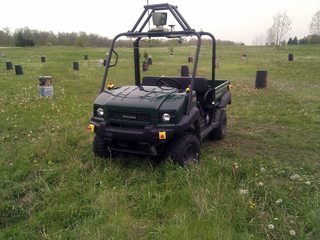MIT creates an electronic "co-pilot"; Google talks about drones
 At the Massachusetts Institute of Technology, an automobile “co-pilot” was developed, which monitors the situation on the road and intervenes only with the threat of an accident. For example, if the driver falls asleep, the device is activated and will drive the vehicle until the person wakes up.
At the Massachusetts Institute of Technology, an automobile “co-pilot” was developed, which monitors the situation on the road and intervenes only with the threat of an accident. For example, if the driver falls asleep, the device is activated and will drive the vehicle until the person wakes up.Sterling Anderson and Karl Iahnemma took part in the project. While a person performs adequate control, the system constantly evaluates it, but if he makes a mistake, regarded as sufficient to switch to self-management mode, the device begins to act.
The co-pilot has a camera and a laser rangefinder for finding obstacles, data from which, together with various data points (driver behavior, vehicle speed, stability and physical characteristics) are taken into account when creating conditions. Until the driver breaks them down, the device does not interfere with him in any way, but as soon as he or external causes (for example, a severely slowing road user in front) violates them, the car starts to be controlled robotized until it is again reached a safe state.
')
During the tests of the system in a small obstacle course in Saleen, Michigan, Anderson noticed an interesting psychological effect: those who trust the “second pilot” detour faster than those who do not have confidence in the system. At the moment, 1,200 system tests were performed, and only in some it did not work, most often due to an error in determining the obstacle. In the video in which the authors of the project explained the principles of action, unfortunately, there are not enough real examples of saving human lives:
The team hopes to try to make a similar system based on the phone and use its camera, accelerometer and other sensors, which will significantly reduce the cost of the device.
The “second pilot” can be contrasted with completely independent Google machines, which are designed for continuous control of the machine and rare human intervention. You can find flaws in the Google approach: people lose their driving skills if all the cars are “on their own”. A person who has relaxed in the driver’s seat is unlikely to be able to quickly respond to an unforeseen situation, and numerous plane crashes involving the autopilot can be a confirmation.
 A few days ago, Eric Schmidt reported on his negotiations with car manufacturers. Unfortunately, the device of the robot-car is not yet ready for mass production, there is a hitch and with the legal component of the question: now there is permission in the USA for robotic cars only in Nevada. The biggest problem is that the unmanned vehicle drives at the speed allowed by the law; such a speed limit for a person is uncharacteristic. Schmidt said that Google has a racing platform on which drones will compete with cars running people.
A few days ago, Eric Schmidt reported on his negotiations with car manufacturers. Unfortunately, the device of the robot-car is not yet ready for mass production, there is a hitch and with the legal component of the question: now there is permission in the USA for robotic cars only in Nevada. The biggest problem is that the unmanned vehicle drives at the speed allowed by the law; such a speed limit for a person is uncharacteristic. Schmidt said that Google has a racing platform on which drones will compete with cars running people.Eric told about several new details: a passenger of a robotic vehicle will simply enter the address into some improved version of Google Maps, and Google’s autopilot will be comparable to the aircraft’s autopilot: a person will be able to easily take control. Schmidt cited convincing statistics on road deaths caused by alcohol, and said that the speed at which mass production of robotic machines was achieved would directly affect the number of lives saved.
Only over time will it become clear whether the confrontation between the two types of cars will become significant - autonomous, compacting traffic and reducing fuel consumption, and semi-autonomous, not relaxing driving skills, but saving the lives of a pedestrian who has jumped onto the road.
Materials on the topic: mit.edu , report .
Source: https://habr.com/ru/post/147904/
All Articles